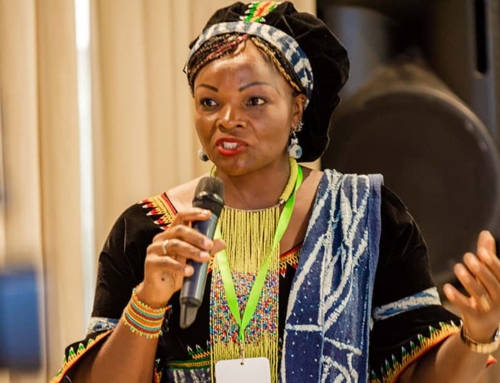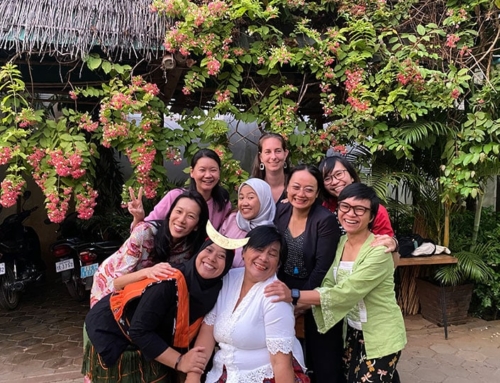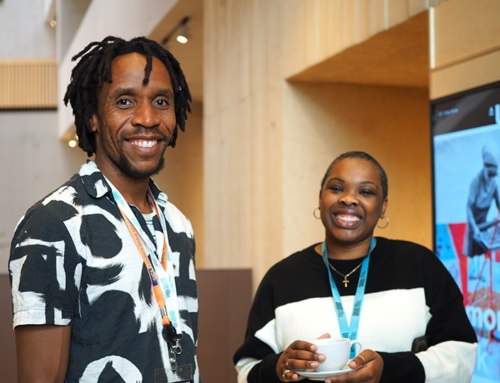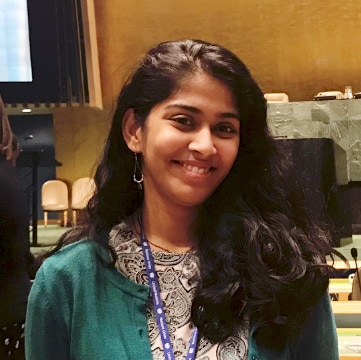
Young people’s voices matter today, not just because of the future they represent. Convincing global leaders to engage with and listen to young people has been a huge success over the last decade, but despite its accomplishments, the youth movement still struggles with one of its earliest challenges: lack of funding.
Funding youth has never been more important; Synchronicity Earth’s Youth Affiliate Swetha Stotra Bhashyam tells us how environmental philanthropy can best support the growing youth biodiversity movement.
In September 2021, Swetha Stotra Bhashyam spoke at the World Conservation Congress in Marseille. Representing the Global Youth Biodiversity Network (GYBN), she spoke alongside Synchronicity Earth co-Founder and Trustee Jessica Sweidan, and this began a discussion between the two organisations about how funders can provide better support to young people in the biodiversity movement.
“It was before the Convention on Biological Diversity (CBD) COP15 in Montreal,” says Swetha, “and there was so much work to be done, we needed to give one last push. We needed young people to be able to go to their governments and engage with them in country before the big United Nations meeting, so the governments already know what young people are pushing for and are more inclined to support it. But in order to do this, you need to be able to take a train, pay for food, and even though young people are doing this work and have for a long time, we still struggle to receive funding for it.
“So, when Synchronicity Earth asked us what we needed, we asked for a grant to support this work… and they just said ‘Okay’. We’d never received an unrestricted grant before [where the organisation receiving funds decides how it can be used]. It was the least complicated grant we’ve ever had, and it was actually healing after the many traumatising fundraising experiences we’ve had for many years, because for the first time, a funder just trusted us.”

As Indigenous Terena youth, Cerizi Francelino and Taily Terena were invited to participate in COP27 and share their perspective from the Brazilian Pantanal and Cerrado, supported by Synchronicity Earth. Image © Katie Maehler
Empowering youth on the global stage
GYBN aims to ensure that youth decisions and priorities are reflected in the goals and targets of the CBD and that youth remain a key stakeholder (along with Indigenous communities, women, and children) in biodiversity conservation. The CBD COP15 in Montreal was a huge success for GYBN, which managed to influence six key policy demands that they had asked for.
“We couldn’t have done it without all the preparation before. By the time the young people arrived at COP15, they already knew the negotiators and were talking to them as pals, so we were able to push them to get what we all wanted and it was a far greater success than we had expected, getting everything we asked for.”
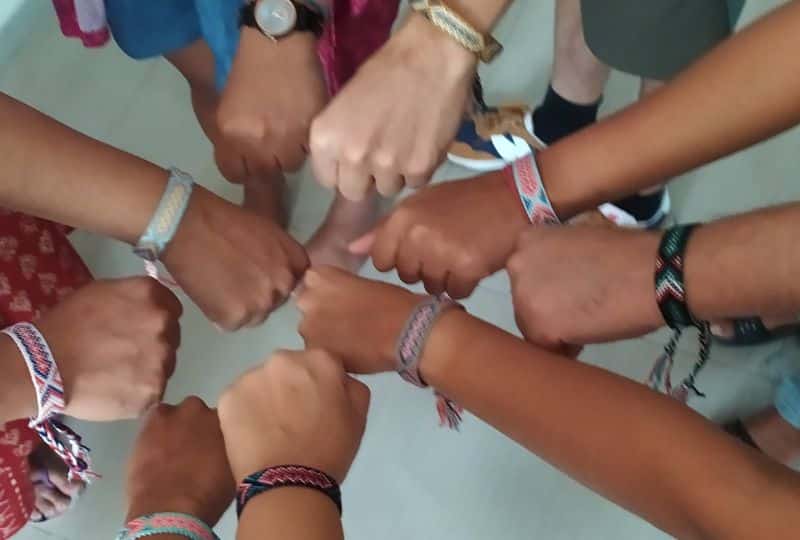
In March 2024, the Global Youth Biodiversity Network brought together key partners to create a bigger understanding of youth challenges, priorities and solutions and foster an opportunity to work together to discuss common ideas and possible collaborations. © GYBN
“Fundraising was always a traumatising experience for us”
Since 2012, GYBN has been the officially recognised coordination platform for youth participation in the negotiations under the CBD, but despite all the work young people have already been doing for biodiversity conservation, they face a constant battle to fund their work.
One of the first challenges was that young people did not have contacts with philanthropists and foundations that were interested in biodiversity, and did not know how to approach organisations for funding. They began to ask the environmental ministries of the governments that they were engaging with, but the process was excessively detailed and unreliable.
“We had to provide every single cost on our budget lines, every single flight, every single person, and these were the costs that were approved and nothing else. We were fine with that, because we wanted to prove ourselves, but then after we did that and asked, do you think you can support our work more broadly, all we heard was no. We continued to do our work unpaid because we are passionate and we know how important it is, and eventually started to convince them to agree to fund us… but then sometimes it would take up to 18 months after applying for us to receive the funds.
“The whole time we are constantly going back and forth with funders to make sure that they have not forgotten us and they’re definitely going to give us the money. So much unpaid work goes into the process of receiving the funds, and after all that time when it does arrive, we absolutely cannot deviate from the budget. But that flexibility is really important- for example, when COVID-19 meant we had to cancel in-person events.
“It comes down to trust. Many funders seemed to think that because we are young people we do not know how to do things well, and we were not always treated with professional respect. If we have to change something on a budget line or if a receipt has something additional on it, they won’t give us the money. There have been so many times where we have done all this work just to hear that now we are ineligible for this funding. But we don’t have a backup budget, so it just comes from our salaries. So that’s why fundraising was always a traumatising experience for us.”

GYBN’s Rwanda chapter using local radio to engage people on biodiversity issues. © GYBN Rwanda
Chrysalis Youth Fund
As Synchronicity Earth’s Youth Affiliate, Swetha has been helping to develop the Chrysalis Youth Fund. The Chrysalis Youth Fund was launched at New York Climate Week in 2023, supporting young leaders and youth groups to shape and implement policy, from the preparations to the negotiations themselves and the follow-up afterwards.
“There are two types of grants,” says Swetha. “The mobilisation grants are small grants that can be sorted quickly to enable someone to attend a conference or fund a project on the ground. And the movement grants are for long-term engagement towards greater change. Thanks to the pooled fund model, young people can receive funding without having to figure out complex bureaucracy, and we are able to access funders that we couldn’t have previously reached.
“It is so much more trust-based. The funds arrive faster, it’s not complicated, and it caters to their needs.”
The Chrysalis Youth Fund is now looking to take another step up the youth engagement ladder (explained in Swetha’s interview) through a youth committee, where young people themselves will make the decisions about where funding will go.

Members of the GYBN team celebrating the Hindu festival of Holi in India. © GYBN
Funding the youth biodiversity movement
As Swetha described in her interview with Synchronicity Earth, despite very limited resources and having to fight to justify their presence within the biodiversity movement, young people have accomplished so much over the past ten years. Moving forward, Swetha hopes that conservation stakeholders such as governments and organisations will be more open to supporting the youth movement financially, and be more mindful of the limitations of fundraising for grassroots movements.
“The youth biodiversity movement cannot just run on passion. If you can see that young people are doing great work, know that this has all been achieved on minimum support. There is so much potential that can only be truly realised if we are funded. Trust that we know how to best spend our money, and then… talk to other funders. You are the ones who can best convince others to start supporting youth work, and that type of support, in the places we can’t reach, is so valuable.”
Swetha is hopeful that a model like the Chrysalis Youth Fund will bring in more of the kind of support that the biodiversity youth movement has needed for so long. She says, “The Chrysalis Youth Fund feels like it is healing the youth community itself. For the people who have been running this movement for so long, and never been acknowledged or valued, it feels good to finally be trusted. If we can work with more funders like this, we will not just be by ourselves, we will feel more loved in the world and we feel like we can fight this battle, no matter how bad it is. We can fight it together.”
Swetha has been part of the Youth Working Group at Synchronicity Earth, developing the Chrysalis Youth Fund, a pooled fund that was launched in New York Climate Week in 2023.
Learn more about the Chrysalis Youth Fund, and to find out how you can get involved, please contact our Philanthropy team.


